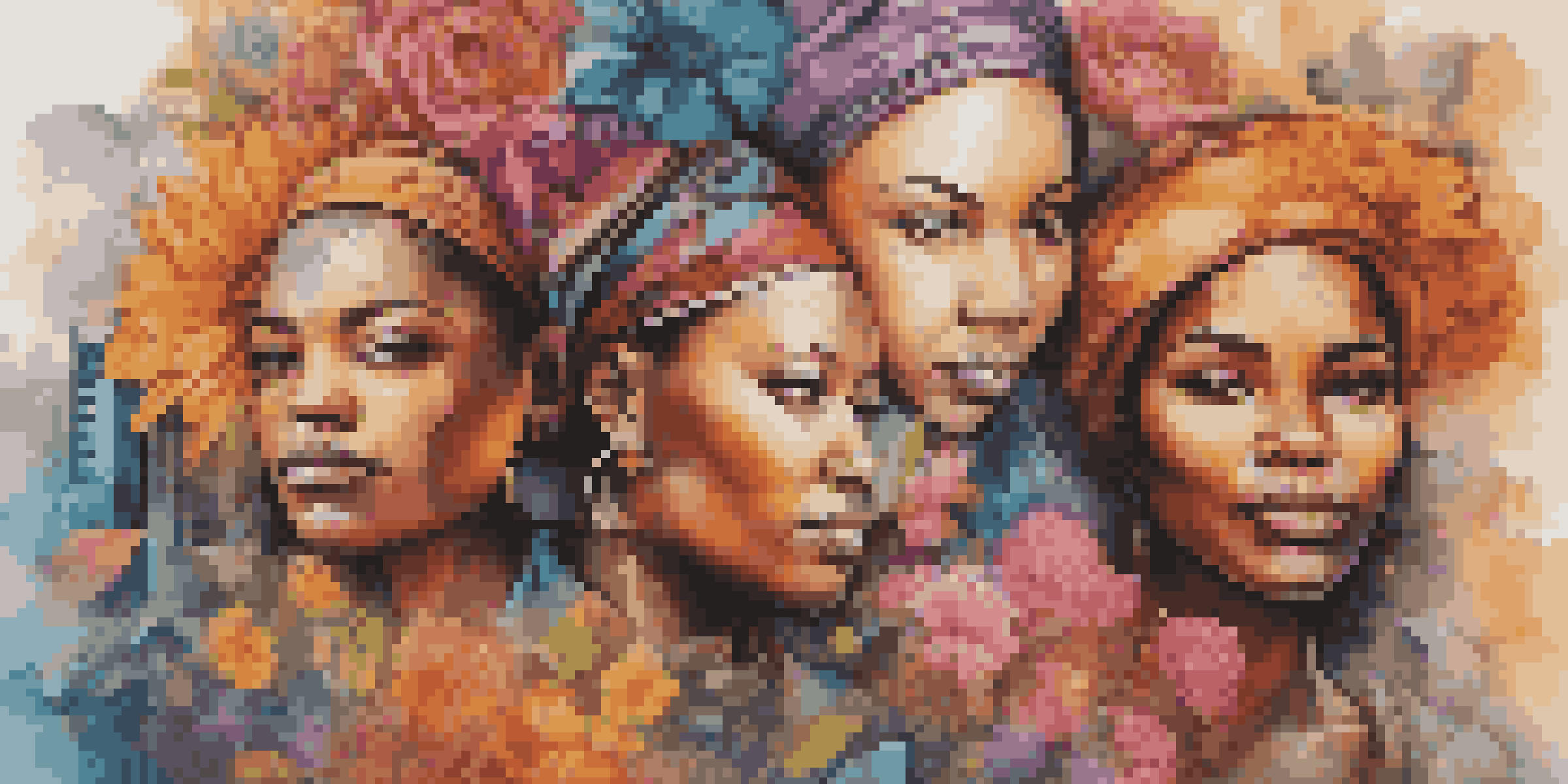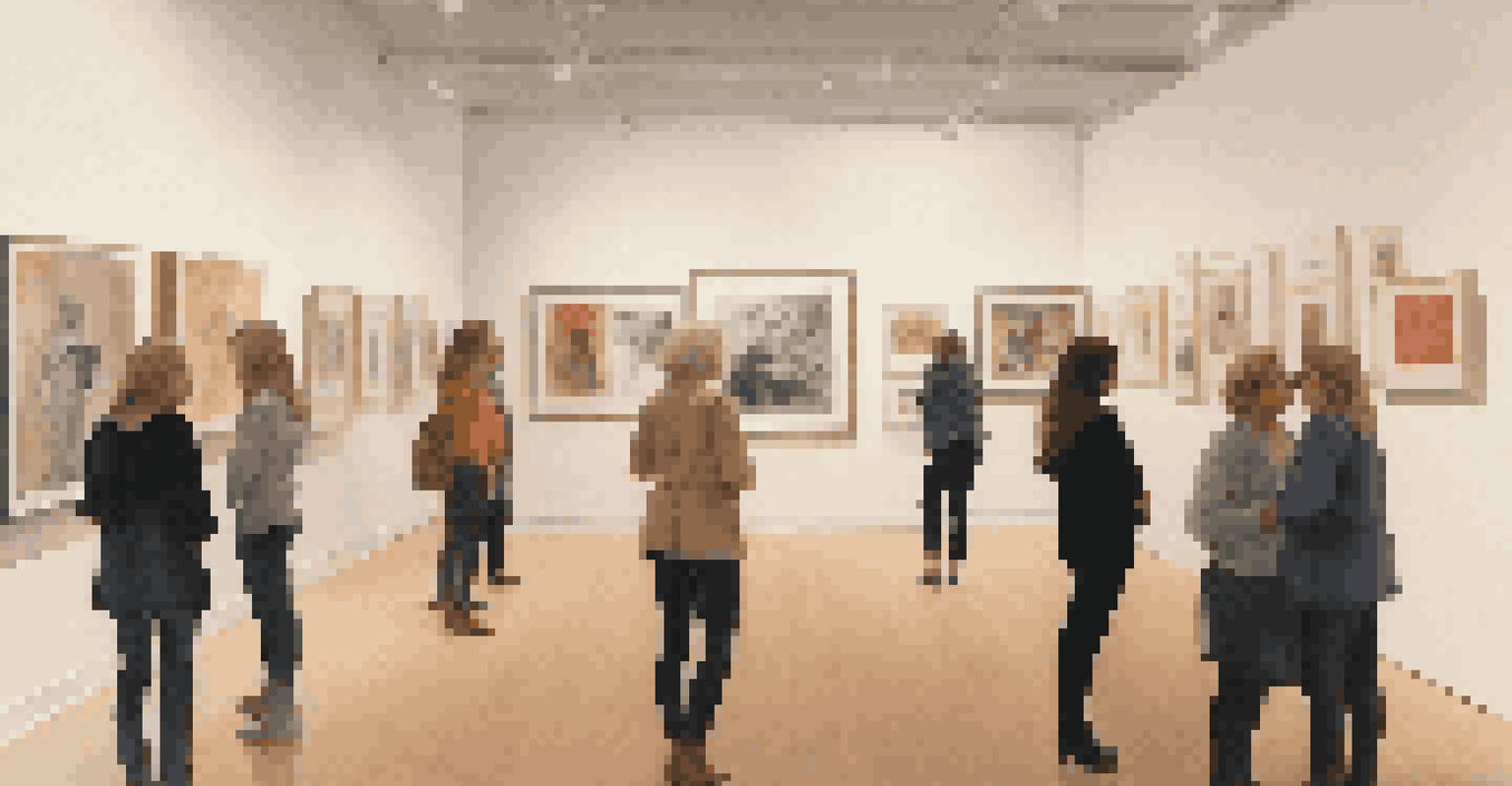Globalization and Feminist Art: A Worldwide Perspective

Understanding Globalization in the Art World
Globalization refers to the interconnectedness of cultures, economies, and societies worldwide. In the art world, this means that artists from different backgrounds can share their work and ideas across borders, creating a rich tapestry of influences. This phenomenon has led to a blending of styles, themes, and techniques, making art more accessible than ever before.
Art is a universal language that transcends borders, connecting us in ways that words cannot.
As artists collaborate internationally, they bring their unique cultural perspectives, challenging traditional narratives. This cross-pollination often leads to innovative art forms that reflect a broader spectrum of human experience. In this way, globalization not only transforms art but also the conversations surrounding it.
However, with this increased interconnectedness comes the risk of homogenization, where local cultures might be overshadowed by dominant global trends. It's essential to navigate this landscape carefully, ensuring that diverse voices, especially those of marginalized communities, are amplified rather than silenced.
Feminist Art: A Historical Overview
Feminist art emerged in the late 1960s as a response to the male-dominated art world. Artists began to challenge societal norms and explore themes related to gender, identity, and power dynamics. This movement sought not only to create art that represented women's experiences but also to question the very definitions of art itself.

Key figures like Judy Chicago and Miriam Schapiro paved the way, using their art to highlight issues such as gender inequality and the representation of women in history. Their work often included collaborative elements, emphasizing the importance of community and shared experiences. This collective approach resonated with many, sparking a global dialogue about women's rights and representation.
Globalization Enriches Art Diversity
Globalization allows artists from diverse backgrounds to collaborate, creating innovative art that reflects a wider range of human experiences.
Feminist art has evolved over the decades, adapting to changing social landscapes. Today's artists continue to explore these themes, often incorporating global perspectives that reflect the diverse experiences of women worldwide.
The Impact of Globalization on Feminist Art
Globalization has significantly influenced feminist art, allowing for a wider exchange of ideas among artists from different cultural backgrounds. This has led to a more inclusive understanding of feminism, recognizing that women's experiences are not monolithic but vary greatly across different societies. These diverse narratives enrich the feminist art movement, making it more relevant and impactful.
Feminism is not just a movement; it's a perspective that encompasses diverse experiences and challenges the status quo.
Through social media and digital platforms, artists can share their work and connect with audiences globally, breaking down geographical barriers. For instance, a female artist in India can collaborate with a counterpart in Brazil, creating pieces that reflect their unique cultural contexts while addressing universal themes of gender inequality. These collaborations often lead to groundbreaking works that resonate on multiple levels.
However, this global exchange also raises questions about representation and authenticity. It's crucial for artists to approach these collaborations with sensitivity and awareness, ensuring that they respect and honor the cultural contexts from which they draw inspiration.
Local vs. Global Narratives in Feminist Art
As feminist art gains global attention, it’s essential to balance local narratives with broader themes. Local artists often bring unique perspectives shaped by their cultural backgrounds and personal experiences. By highlighting these stories, artists can challenge dominant narratives and offer a more nuanced view of feminism.
For example, while Western feminist art might focus on issues like body image and workplace equality, artists from other regions may address topics like migration, violence, and cultural identity. This diversity enriches the feminist art movement, fostering empathy and understanding among audiences worldwide. It encourages viewers to consider how these issues intersect and influence one another.
Feminist Art Reflects Cultural Contexts
Feminist art not only addresses gender issues but also emphasizes the importance of local narratives, showcasing the varied experiences of women worldwide.
Ultimately, integrating local narratives into the global discourse allows for a more comprehensive understanding of feminism. It reminds us that while we may share common goals, our paths to achieving them can look very different.
Case Studies: Feminist Artists Around the Globe
Examining the works of feminist artists worldwide offers valuable insights into how globalization shapes their art. For instance, Ai Weiwei’s collaborations with female artists from various countries highlight the importance of collective action in addressing social injustices. His projects often explore themes of freedom and oppression, resonating with audiences far beyond his native China.
In contrast, artists like Shirin Neshat from Iran use their work to delve into the complexities of identity and cultural heritage. Through film and photography, she addresses issues of gender, power, and the impact of political unrest on women's lives. Her art invites viewers to reflect on the nuances of feminism in a specific cultural context while still engaging with global feminist discourse.
These case studies illustrate that feminist art is not only about women’s experiences but also about the broader societal structures that shape those experiences. By exploring different artistic expressions, we can appreciate the richness of feminist art in a globalized world.
Challenges Faced by Feminist Artists in a Globalized World
Despite the opportunities that globalization presents, feminist artists often face significant challenges. Issues such as funding, representation in major exhibitions, and access to resources can hinder their ability to create and share their work. Many artists, particularly those from marginalized communities, struggle to have their voices heard in a crowded art landscape.
Moreover, the risk of cultural appropriation looms large in a globalized art scene. Artists must navigate the fine line between drawing inspiration from other cultures and exploiting them for commercial gain. This requires a deep understanding and respect for the cultural contexts they engage with, ensuring that their work does not perpetuate harmful stereotypes.
Challenges in a Globalized Art Scene
Despite new opportunities, feminist artists face challenges such as funding and cultural appropriation, necessitating advocacy for equity and visibility.
Advocating for equity and visibility in the art world is essential for overcoming these challenges. By supporting feminist initiatives and promoting diverse voices, we can help create a more inclusive art landscape that values the contributions of all artists.
The Future of Feminist Art in a Global Context
As we look ahead, the future of feminist art appears promising yet complex. With ongoing dialogues about gender equality and representation, artists are poised to continue pushing boundaries and exploring new mediums. The integration of technology and social media will likely play a significant role in shaping the next wave of feminist art.
Artists are increasingly using digital platforms to create immersive experiences that challenge traditional forms of art. Virtual reality, for instance, allows for innovative storytelling that can engage audiences in unique ways. By harnessing these tools, feminist artists can reach wider audiences and spark conversations about pressing social issues.

Ultimately, the future of feminist art will depend on a commitment to inclusivity and collaboration. By embracing diverse perspectives and uplifting marginalized voices, the feminist art movement can continue to evolve and inspire change on a global scale.